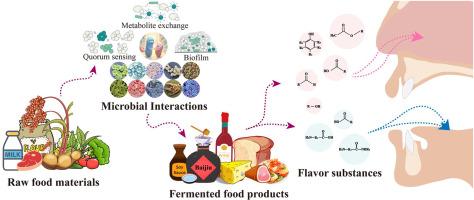微生物群相互作用是发酵食品风味发展的关键决定因素
IF 15.4
1区 农林科学
Q1 FOOD SCIENCE & TECHNOLOGY
引用次数: 0
摘要
发酵食品的复杂风味特征是通过动态的微生物相互作用而不是单个微生物活动产生的。传统的研究主要集中在风味化合物的鉴定和产品的改进上,而当代的研究越来越强调微生物群落动态在风味发展中的关键作用。本文从三个方面探讨了微生物相互作用在发酵食品风味开发中的关键作用:(1)微生物相互作用类型及其相关风味化合物;(2)微生物动力学与风味形成的双向调控;(3)基因组尺度代谢模型在阐明这些关系中的应用。合作代谢交换促进了理想风味化合物和芳香谱的形成,这在单一栽培系统中尚不发达。竞争性相互作用同时抑制了不需要的物种,从而消除了异味的产生,同时将代谢通量转向有益的化合物。群体感应机制通过同步群体范围内的基因表达进一步调节这些过程,通过协调的代谢途径优化风味生物合成。生物膜的形成创造了专门的物理化学微环境,提高了代谢效率,促进了风味化合物的积累。先进的分析方法,特别是基因组尺度的代谢模型,已经成为阐明这些复杂的相互作用网络不可或缺的工具。对微生物群落动态的系统级理解可以实现发酵食品的精确风味工程和质量提高,强调超越单一物种优化的生态管理策略的必要性。本文章由计算机程序翻译,如有差异,请以英文原文为准。

Microbiota interactions as critical determinants of flavor development in fermented foods
Background
The complex flavor profiles characteristics of fermented foods emerge through dynamic microbial interactions rather than individual microbial activities. While traditional research primarily focused on flavor compound identification and product enhancement, contemporary studies increasingly highlight the pivotal role of microbial community dynamics in flavor development.
Scope and approach
This review explores the critical role of microbial interactions in fermented food flavor development, with three focal points: (1) microbial interaction types and their associated flavor compounds; (2) bidirectional regulation between microbial dynamics and flavor formation; and (3) applications of genome-scale metabolic modeling in elucidating these relationships.
Key findings and conclusions
Cooperative metabolic exchange drives the formation of desirable flavor compounds and aromatic profiles, which remain underdeveloped in monoculture systems. Competitive interactions simultaneously suppress undesirable species, thereby eliminating off-flavor production while redirecting metabolic flux toward beneficial compounds. Quorum sensing mechanisms further regulate these processes by synchronizing population-wide gene expressions to optimize flavor biosynthesis through coordinated metabolic pathways. Biofilm formation creates specialized physicochemical microenvironments that enhance metabolic efficiency and facilitate flavor compound accumulation. Advanced analytical approaches, particularly genome-scale metabolic modeling, have become indispensable tools for elucidating these complex interaction networks. A systems-level understanding of microbial community dynamics enables precise flavor engineering and quality enhancement in fermented foods, underscoring the necessity of ecological management strategies that transcend single-species optimization.
求助全文
通过发布文献求助,成功后即可免费获取论文全文。
去求助
来源期刊

Trends in Food Science & Technology
工程技术-食品科技
CiteScore
32.50
自引率
2.60%
发文量
322
审稿时长
37 days
期刊介绍:
Trends in Food Science & Technology is a prestigious international journal that specializes in peer-reviewed articles covering the latest advancements in technology, food science, and human nutrition. It serves as a bridge between specialized primary journals and general trade magazines, providing readable and scientifically rigorous reviews and commentaries on current research developments and their potential applications in the food industry.
Unlike traditional journals, Trends in Food Science & Technology does not publish original research papers. Instead, it focuses on critical and comprehensive reviews to offer valuable insights for professionals in the field. By bringing together cutting-edge research and industry applications, this journal plays a vital role in disseminating knowledge and facilitating advancements in the food science and technology sector.
 求助内容:
求助内容: 应助结果提醒方式:
应助结果提醒方式:


